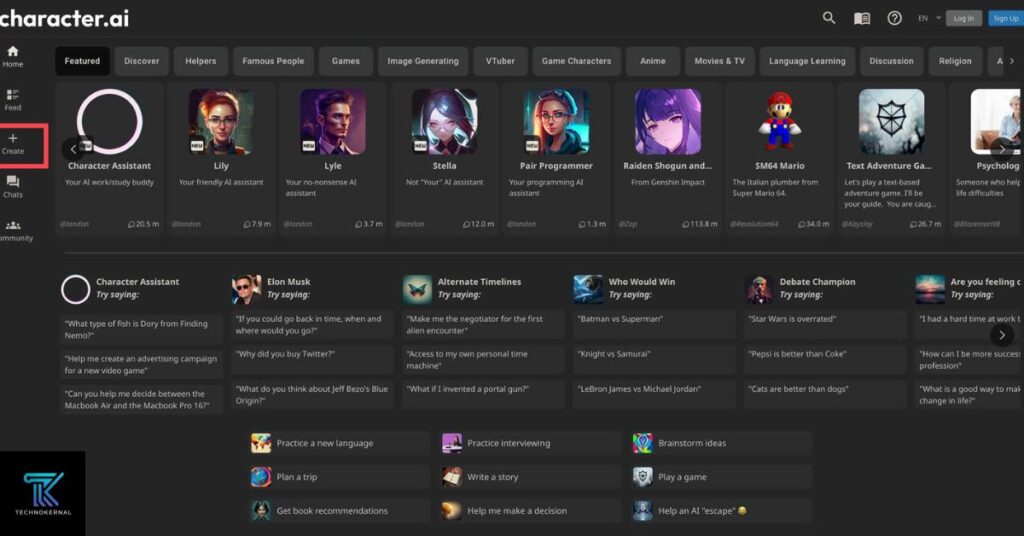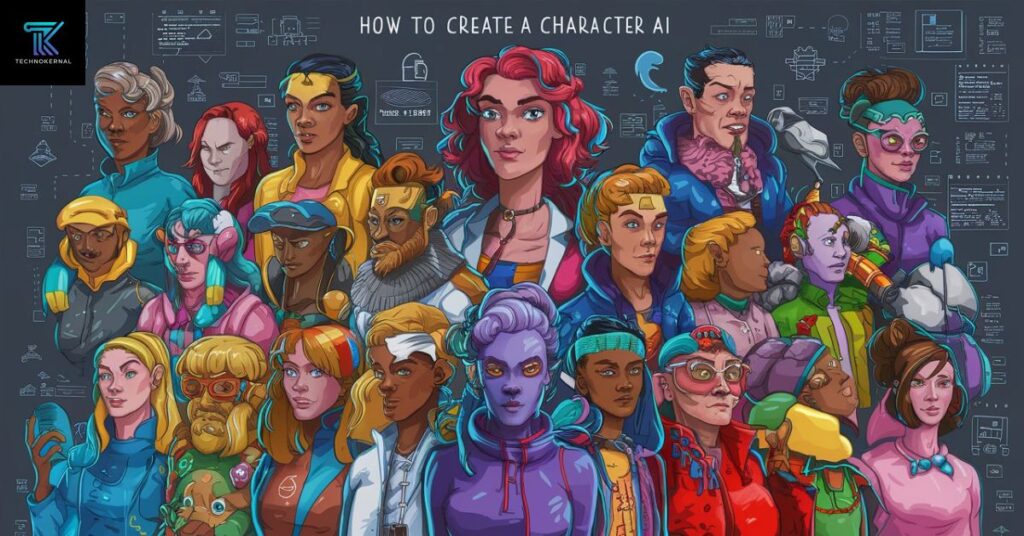Creating a character AI involves a multi-faceted process aimed at designing digital entities capable of simulating human-like behavior and interactions. In this informational guide, we’ll explore the intricacies of crafting character AI, from defining personality traits to integrating conversational abilities and visual identities.
Character AI development requires a blend of technical expertise and creative vision, as developers strive to imbue these virtual beings with engaging personalities and lifelike attributes. By understanding the core components of character AI, such as emotional intelligence and dialogue design.
The creators can shape immersive experiences that resonate with users across various applications. Throughout this journey, we’ll delve into practical strategies, ethical considerations, and the latest advancements in the field, empowering readers to embark on their own character AI endeavors with confidence and insight.
Understanding the Core Components of Character AI Development
Character AI development entails the intricate process of constructing digital personas capable of emulating human-like traits and behaviors. At its core, this endeavor involves integrating several key components to create a cohesive and compelling virtual entity.
Firstly, defining the personality traits of the character serves as the foundation of its AI development. This includes determining characteristics such as temperament, preferences, and behavioral tendencies, which shape the character’s interactions and responses.
Secondly, crafting the character’s visual identity plays a crucial role in enhancing its appeal and relatability. Design elements such as facial expressions, body language, and aesthetic features contribute to the character’s overall persona and help establish a connection with users.
This incorporating conversational abilities is essential for fostering meaningful interactions between the character and users. This involves scripting natural and engaging dialogue, implementing natural language processing techniques, and fine-tuning the character’s responses to ensure seamless communication.
By integrating emotional intelligence allows the character to perceive, interpret, and express emotions authentically. By incorporating emotion recognition algorithms and expressive capabilities, character AI can respond empathetically and adaptively to user interactions, enhancing the overall user experience.
Overall, understanding and integrating these core components – personality traits, visual identity, conversational abilities, and emotional intelligence – are essential for effective character AI development, enabling creators to craft immersive and engaging digital experiences that resonate with users on a deeper level.
Crafting Memorable Personality Traits for Character AI
Crafting memorable personality traits for character AI involves a nuanced approach that intertwines psychology with creative design. It begins with a deep understanding of human behavior and emotions, enabling developers to identify key traits that will define the character’s uniqueness.
Each trait must be carefully selected and tailored to suit the character’s intended purpose and the context in which it will interact with users. By balancing contrasting traits, such as introversion and extroversion or kindness and cynicism, developers can create dynamic and relatable characters that resonate with audiences.
The infusing the character with a rich backstory and life experiences adds depth and complexity, fostering a deeper connection with users. Utilizing archetypes as a framework provides a solid foundation for character development,
While constant testing and refinement based on user feedback ensure that the character’s personality remains authentic and engaging. Consistency in behavior and responses is key to maintaining believability and immersion, ultimately culminating in a character AI that leaves a lasting impression on users.
Mastering Conversational Skills: Dialogue Design for Character AI
In crafting dialogue for character AI, mastering conversational skills is paramount to creating engaging and lifelike interactions. Here’s how:
- Understand natural speech patterns and conversational cues.
- Develop a diverse repertoire of responses to foster dynamic conversations.
- Implement sentiment analysis to gauge user emotions and tailor responses accordingly.
- Utilize machine learning algorithms to enhance dialogue generation and coherence.
- Incorporate contextual awareness to maintain relevance and continuity in conversations.
Table: Sample Dialogue Design Framework for Character AI
| Dialogue Context | Response |
| Greeting | “Hello there! How can I assist you today?” |
| Inquiry | “What can I help you with?” |
| Expressing Emotion | “I’m sorry to hear that. Is there anything I can do to help?” |
| Providing Information | “Sure, let me find that information for you.” |
| Expressing Gratitude | “Thank you for your kind words! It’s my pleasure to assist.” |
Mastering conversational skills in dialogue design for character AI is crucial for creating immersive and satisfying user experiences. By understanding natural speech patterns, tailoring responses to user emotions, and maintaining contextual awareness, developers can ensure that their character AI engages users in meaningful and dynamic conversations, ultimately enhancing the overall user experience.
Visual Identity: Designing Appealing Character AI
Crafting the visual identity of character AI involves meticulous attention to detail and creative design considerations. Here’s a detailed breakdown:
- Defining Visual Aesthetics: Begin by defining the overall aesthetic style of the character, considering factors such as realism, stylization, or abstract representation.
- Facial Expressions and Body Language: Design expressive facial features and body language that convey emotions and personality traits effectively. Incorporate a range of expressions and gestures to make the character feel dynamic and relatable.
- Color Palette and Design Elements: Choose a cohesive color palette and design elements that align with the character’s personality and intended audience. Experiment with color psychology to evoke specific emotions or associations.
- Customization Options: Provide customization options for users to personalize their character AI, such as selecting clothing styles, accessories, or physical attributes. This enhances user engagement and allows for a more personalized experience.
- Animation and Motion: Implement fluid animation and motion effects to bring the character AI to life. Pay attention to movement dynamics, timing, and transitions to ensure a natural and convincing animation.
- User Interface Integration: Integrate the character AI seamlessly into user interfaces, considering factors such as size, placement, and interaction methods. Ensure that the visual design complements the overall UI design aesthetic.
- Accessibility Considerations: Design character AI visuals with accessibility in mind, considering factors such as color contrast, readability, and scalability for users with diverse needs.
- Cross-Platform Compatibility: Optimize visual assets for cross-platform compatibility, ensuring consistency and quality across different devices and screen sizes.
- Iterative Design Process: Implement an iterative design process, gathering feedback from users and stakeholders to refine and improve the visual identity of the character AI over time.
Designing the visual identity of character AI involves a combination of artistic creativity, user-centric design principles, and technical proficiency. By focusing on defining visual aesthetics, creating expressive facial expressions and body language.
By customizing options for users, integrating seamless animation and motion, considering accessibility, ensuring cross-platform compatibility, and iterating through feedback, developers can create appealing character AI that captivates users and enhances the overall user experience.
Empowering Character AI: Integrating Emotional Intelligence
In the realm of character AI development, the integration of emotional intelligence marks a significant stride towards creating more immersive and empathetic virtual entities. Here’s a comprehensive exploration of this crucial aspect:
Emotional intelligence encompasses the ability to perceive, understand, and express emotions, both in oneself and others. When applied to character AI, it enables these digital beings to interpret user emotions,
The respond empathetically, and adapt their behavior accordingly. This integration enhances the character’s ability to engage with users on a deeper level, forging meaningful connections and fostering a sense of rapport.
To effectively integrate emotional intelligence into character AI, developers leverage advanced technologies such as emotion recognition algorithms, sentiment analysis and natural language processing.
These tools enable the character AI to discern subtle cues in user interactions such as tone of voice facial expressions, and choice of words allowing them to tailor their responses in a manner that reflects empathy and understanding.
Moreover, the implementation of emotional intelligence requires careful consideration of ethical implications, ensuring that the character AI respects user privacy autonomy, and emotional boundaries. Developers must establish clear guidelines and protocols for handling sensitive information and prioritize user consent and well-being throughout the interaction.
By imbuing character AI with emotional intelligence, developers can create digital companions that not only provide assistance and information but also offer support comfort, and companionship. This transformative integration elevates the user experience fostering deeper engagement trust, and loyalty towards the character AI.
The seamless integration of emotional intelligence empowers character AI to serve as empathetic and responsive companions in the digital realm, enriching the lives of users and redefining the possibilities of human-computer interaction.
READ THIS : Luxury Fintech Zoom: Redefining The Future Of Finance
Ethical Considerations in Character AI Development
When delving into the realm of character AI development, it’s imperative to navigate the complex landscape of ethical considerations with careful consideration and foresight. Here’s a detailed exploration of the key ethical considerations in bullet points:
- Responsible Use of Data: Ensure transparency and accountability in the collection, storage, and utilization of user data. Uphold strict privacy standards and obtain informed consent from users regarding the usage of their personal information.
- Mitigation of Bias and Stereotypes: Guard against the perpetuation of biases and stereotypes in character AI representations. Strive for inclusivity and diversity in character design, avoiding reinforcement of societal prejudices or discriminatory attitudes.
- User Autonomy and Consent: Respect user autonomy by providing clear options for opting in or out of interactions with character AI. Avoid coercive tactics or manipulative techniques that may compromise user consent or agency.
- Avoidance of Harm: Prioritize user well-being and safety in character AI interactions. Refrain from engaging in behaviors or conversations that may cause emotional distress, harm, or discomfort to users.
- Fairness and Equity: Ensure fairness and equity in the distribution of resources, opportunities, and access to services facilitated by character AI. Guard against discriminatory practices or exclusionary behaviors that may perpetuate societal inequalities.
- Accountability and Transparency: Establish mechanisms for accountability and transparency in character AI development and deployment. Provide clear avenues for users to seek recourse or raise concerns regarding the actions or decisions of character AI.
- Continuous Evaluation and Improvement: Commit to ongoing evaluation and improvement of character AI systems to address emerging ethical challenges and mitigate potential harms. Solicit feedback from diverse stakeholders and incorporate ethical considerations into the iterative development process.
By adhering to these ethical principles and considerations, developers can foster trust integrity and societal benefit in character AI development. By prioritizing responsible use of data mitigating bias and stereotypes, respecting user autonomy and consent, avoiding harm.
The promoting fairness and equity, ensuring accountability and transparency, and embracing continuous evaluation and improvement developers can navigate the ethical complexities of character AI development and contribute to the advancement of ethical standards in the field.
The Best Software to Make AI Characters
Selecting the right software for creating AI characters is pivotal for efficient and effective development. Unity stands out as a popular choice, offering robust tools for animation scripting, and interaction along with a vast Asset Store for additional resources.

Unreal Engine, known for its high-fidelity graphics and visual scripting system provides ample customization options through its Marketplace. Autodesk Maya and Blender offer comprehensive 3D modeling and animation capabilities, allowing for intricate character designs.
Adobe Character Animator with its focus on real-time animation and motion capture is ideal for projects requiring rapid prototyping or live performances. By carefully considering project scope, technical requirements, and desired features, developers can select the software best suited to bring their AI characters to life with creativity and precision.
READ THIS : Letflix: Exploring The Wonders Of Streaming Service Application
faqs
How can I create AI characters?
You can create AI characters using software like Unity or Unreal Engine, which offer tools for animation and interaction. Alternatively, consider platforms like Autodesk Maya or Blender for comprehensive 3D modeling and animation capabilities.
What is the best AI tool to make characters with?
The best AI tool for creating characters varies based on your project’s needs, but popular options include Unity, Unreal Engine, Maya, and Blender. Each offers unique features for animation, customization, and interaction.
Does character.ai have an official mobile app?
No, character.ai currently doesn’t have an official mobile app available. Users typically access its services through web browsers on their mobile devices.
What are large language models?
Large language models are advanced AI systems trained on extensive text data to understand and generate human-like language. They utilize deep learning techniques to analyze patterns and context, enabling them to produce coherent and contextually relevant responses.
Conclusion
This journey has been both enlightening and enriching, revealing the intricate tapestry of knowledge woven through the fabric of human experience. As we reflect on the insights gained and the challenges overcome, it becomes clear that our quest for understanding is a perpetual endeavor.
With each conclusion merely serving as a milestone along the path of discovery. While we may have reached the end of this particular exploration, the vast expanse of the unknown beckons us onward, fueling our curiosity and inspiring us to delve deeper into the mysteries of the universe. As we bid farewell to this chapter.
let us carry forth the lessons learned, and the wisdom gained, embracing the endless possibilities that lie ahead with optimism and determination. Thus, with hearts full of gratitude and minds eager for the adventures that await, we bid adieu to this journey knowing that the pursuit of knowledge knows no bounds.

Robert with 4 years of tech experience, brings expertise to our website, driving innovation and technological advancements.







